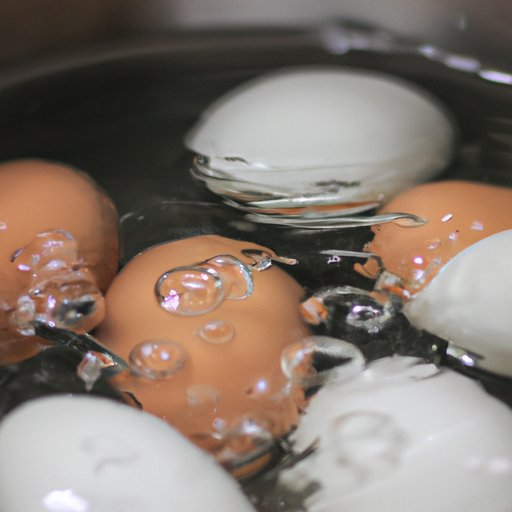
I. Introduction
Boiling eggs is a common task, yet many people still struggle with getting them just right. Overcooked, undercooked, or impossible to peel eggs can be frustrating, but fear not! This article aims to provide you with a complete guideline on boiling eggs. We will explore the exact method for boiling eggs perfectly every time, tips and tricks for easier boiling, different methods to suit your preferences, and various recipes that incorporate boiled eggs.
II. Step-by-Step Guide to Boiling Eggs Perfectly Every Time
Start by gathering materials: a pot, eggs, water, and a timer. Then, follow these five simple steps:
- Place eggs in the pot and cover them with cold water, making sure the water level is at least 1 inch above the eggs.
- Bring the pot to boil over high heat. Once boiled, cover the pot and remove from heat settings.
- Let the eggs cook in the boiling water for a specific amount of time based on desired doneness: 3-4 minutes for soft-boiled eggs, 5-6 minutes for medium-boiled eggs, and 8-12 minutes for hard-boiled eggs.
- Drain the hot water and rinse the eggs with cold water to stop the cooking process.
- Peel the eggs and enjoy!
III. Quick Tips and Tricks for Boiling Eggs
Here are some helpful quick tips and tricks to incorporate if you want to make your egg-boiling process easier:
- To identify what eggs have been boiled for longer, spin them on their side. Soft-boiled eggs will spin quickly, but hard-boiled eggs will spin slowly or not at all.
- Use the ice bath method to stop the cooking process. After boiling the eggs, immediately transfer them to a bowl of ice water. The cold temperature shrinks the egg whites, making them easier to peel.
- Use an egg timer or a stopwatch to time the eggs exact time for desired doneness. Alternatively, you could use the old-fashioned method of watching the clock and eyeballing your egg-boiling time.
IV. Exploring Different Boiling Methods
Here are different methods of boiling eggs to suit your cooking preferences:
- High-altitude boiling: Adjusting the boiling time and method based on elevation to prevent undercooked or overcooked eggs
- Simmered eggs: Bring the eggs to a boil, then lower temperature to achieve creamier, softer egg whites with a runny yolk.
V. Combining boiled eggs with other healthy ingredients for breakfast or snacks
Boiled eggs aren’t just for breakfast! Here are some ways to incorporate boiled eggs into healthy meals and snacks:
- On top of a salad for extra protein and flavor
- In a sandwich with avocado and tomato for a filling lunch
- In a wrap with veggies and hummus for a portable snack on-the-go
Here are a few simple recipes to try incorporating boiled eggs:
- Egg Salad Sandwich: Mix boiled eggs with mayo, mustard, salt, and pepper. Serve on whole-wheat bread with lettuce and tomato.
- Cobb Salad: Combine chopped boiled eggs with lettuce, bacon, avocado, tomato, and chicken. Drizzle with your favorite dressing.
VI. Personal Experiences and Recipes for Boiled Eggs
Boiling eggs is a personal experience, and everyone has their unique style. Here are some of my favorite ways of boiling and serving eggs:
- Delectable Deviled Eggs: Cut boiled eggs in half and scoop out the yolk. Mix the yolk with mayo, mustard, paprika, salt, and pepper before filling up the egg whites.
- Pickled eggs: Combine boiled eggs with white vinegar, water, sugar, and spices like dill or garlic. Refrigerate overnight and serve on crackers for a tangy snack.
VII. Conclusion
Boiled eggs are a versatile and healthy food that can be a part of any meal or snack. By following the step-by-step guide in this article, you can boil eggs perfectly every time. We also discussed helpful tips and tricks, different boiling methods, and various recipes that incorporate boiled eggs.




